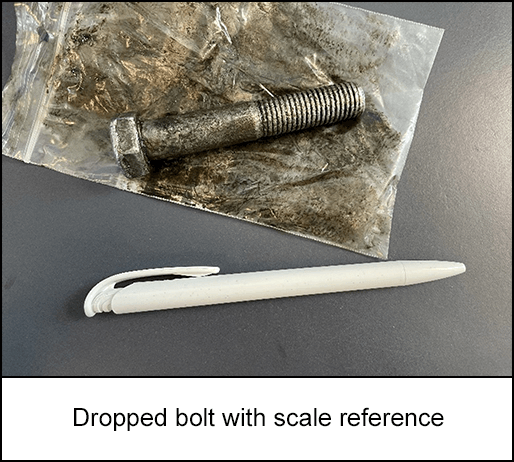-
What happened?
During the start-up of a wind turbine generator (WTG) after service, technicians who were positioned inside the bottom of the tower reported hearing a noise from outside.
Upon investigation, they discovered a bolt weighing 167 grams (0.36 lbs.) on the concrete foundation. It was determined that the bolt had been dropped from the hub when the blades pitched during start-up. The bolt first hit the railing and then landed on the concrete foundation.
At the time of the incident, there were no personnel outside the WTG, and all technicians were safely inside the tower.
Based on calculations, it was estimated that the 167 grams bolt (0.36 lbs.), dropped from a height of 69 meters (226 feet), released 113 joules of energy, which is considered potentially fatal. It corresponds to dropping a 1 kg (2.2 lbs.) object from a height of 12 meters (39 feet).

-
Why did it happen?
The loose bolt found during the incident was not a component of the final hub design. It is believed to have been inadvertently left behind during the manufacturing or installation process.
The final quality check conducted before the hub's release should have ensured that no unintended parts would accompany the hub.

-
What did they learn?
Technicians should actively listen for any loose items in the hub or blades. This practice is believed to reduce the risk of similar incidents occurring.
Contractors should demonstrate the safety and reliability of their work systems independently, without relying on the operator to address any issues. It is important to establish clear responsibilities and avoid placing sole responsibility on the operator for addressing problems related to dropped objects during turbine restarts.
Consideration should be given to the potential impact of releasing a safety notice regarding this specific issue to other sites. It is important to assess whether such a notice would significantly affect the overall risk rating and contribute to improved safety measures.

-
Ask yourself or your crew
What are the risks and hazards associated with wind turbine generator start-ups after service, particularly related to dropped objects from the hub or blades?
What specific measures do you and your team currently take to actively listen for and detect any loose items in the hub or blades before turbine start-up, and how effective do you think these measures are?
What improvements or additional safety protocols do you believe could be implemented to further reduce the risk of similar incidents occurring in the future?
Considering the potential severity of dropped objects during turbine restarts, how do you and your team perceive the roles and responsibilities of both the contractors and the operators in addressing and preventing such incidents? Are there any changes or clarifications needed in these roles?

Add to homescreen
Content name
Select existing category:
Content name
New collection
Edit collection
What happened?
During the start-up of a wind turbine generator (WTG) after service, technicians who were positioned inside the bottom of the tower reported hearing a noise from outside.
Upon investigation, they discovered a bolt weighing 167 grams (0.36 lbs.) on the concrete foundation. It was determined that the bolt had been dropped from the hub when the blades pitched during start-up. The bolt first hit the railing and then landed on the concrete foundation.
At the time of the incident, there were no personnel outside the WTG, and all technicians were safely inside the tower.
Based on calculations, it was estimated that the 167 grams bolt (0.36 lbs.), dropped from a height of 69 meters (226 feet), released 113 joules of energy, which is considered potentially fatal. It corresponds to dropping a 1 kg (2.2 lbs.) object from a height of 12 meters (39 feet).

Why did it happen?
The loose bolt found during the incident was not a component of the final hub design. It is believed to have been inadvertently left behind during the manufacturing or installation process.
The final quality check conducted before the hub's release should have ensured that no unintended parts would accompany the hub.
What did they learn?
Technicians should actively listen for any loose items in the hub or blades. This practice is believed to reduce the risk of similar incidents occurring.
Contractors should demonstrate the safety and reliability of their work systems independently, without relying on the operator to address any issues. It is important to establish clear responsibilities and avoid placing sole responsibility on the operator for addressing problems related to dropped objects during turbine restarts.
Consideration should be given to the potential impact of releasing a safety notice regarding this specific issue to other sites. It is important to assess whether such a notice would significantly affect the overall risk rating and contribute to improved safety measures.
Ask yourself or your crew
What are the risks and hazards associated with wind turbine generator start-ups after service, particularly related to dropped objects from the hub or blades?
What specific measures do you and your team currently take to actively listen for and detect any loose items in the hub or blades before turbine start-up, and how effective do you think these measures are?
What improvements or additional safety protocols do you believe could be implemented to further reduce the risk of similar incidents occurring in the future?
Considering the potential severity of dropped objects during turbine restarts, how do you and your team perceive the roles and responsibilities of both the contractors and the operators in addressing and preventing such incidents? Are there any changes or clarifications needed in these roles?
During the start-up of a wind turbine generator (WTG) after service, technicians who were positioned inside the bottom of the tower reported hearing a noise from outside. Upon investigation, they discovered a bolt on the concrete foundation. Based on calculations, it was estimated that the bolt dropped from a height of 69 meters (226 feet), released 113 joules of energy, which is considered potentially fatal.










